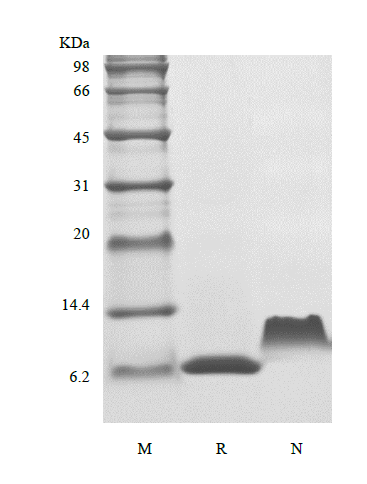- Synonyms
-
- Source
- Escherichia coli.
- Molecular Weight
- Approximately 8.1 kDa, a single non-glycosylated polypeptide chain containing 71 amino acids.
- AA Sequence
- ARGTNVGREC CLEYFKGAIP LRKLKTWYQT SEDCSRDAIV FVTVQGRAIC SDPNNKRVKN AVKYLQSLER S
- Purity
- > 97 % by SDS-PAGE and HPLC analyses.
- Biological Activity
- Fully biologically active when compared to standard. The biological activity determined by a chemotaxis bioassay using human T-lymphocytes is in a concentration range of 1.0-10 ng/ml.
- Physical Appearance
- Sterile Filtered White lyophilized (freeze-dried) powder.
- Formulation
- Lyophilized from a 0.2 μm filtered concentrated solution in 20mM PB, pH 7.4, 150mM NaCl.
- Endotoxin
- Less than 1 EU/μg of rHuTARC/CCL17 as determined by LAL method.
- Reconstitution
- We recommend that this vial be briefly centrifuged prior to opening to bring the contents to the bottom. Reconstitute in sterile distilled water or aqueous buffer containing 0.1 % BSA to a concentration of 0.1-1.0 mg/mL. Stock solutions should be apportioned into working aliquots and stored at ≤ -20 °C. Further dilutions should be made in appropriate buffered solutions.
- Stability & Storage
- Use a manual defrost freezer and avoid repeated freeze-thaw cycles.
- 12 months from date of receipt, -20 to -70 °C as supplied.
- 1 month, 2 to 8 °C under sterile conditions after reconstitution.
- 3 months, -20 to -70 °C under sterile conditions after reconstitution.
- Usage
- This material is offered by Shanghai PrimeGene Bio-Tech for research, laboratory or further evaluation purposes. NOT FOR HUMAN USE.
- SDS-PAGE

- Reference
- 1. Loftus BJ, Kim UJ, Sneddon VP, et al. 1999. Genomics, 60: 295-308.
2. Imai T, Yoshida T, Baba M, et al. 1996. J Biol Chem, 271: 21514-21.
3. Jakubzick C, Wen H, Matsukawa A, et al. 2004. Am J Pathol, 165: 1211-21.
4. Shimada Y, Takehara K, Sato S. 2004. J Dermatol Sci, 34: 201-8.
5. Sumiyoshi K, Nakao A, Setoguchi Y, et al. 2003. J Dermatol Sci, 31: 53-8.
- Background
- Human CCL17 also known as thymus and activation-related chemokine (TARC) is encoded by the CCL17 gene located on the chromosome 16 in humans. It is expressed by thymus cells constitutively and phytohemagglutinin-stimulated peripheral blood mononuclear cells transiently. CCL17 signals through the chemokine receptors CCR4 and CCR8 and displays chemotactic activity for T lymphocytes and some other leukocytes. It plays an important role in skin diseases such as atopic dermatitis, bullous pemphigoid and mycosis fungoides. CCL17 has approximately 24 – 29 % amino acid sequence identity with RANTES, MIP-1α, MIP-1β, MCP-1, MCP-2, MCP-3 and I-309.







 COA申请
COA申请
